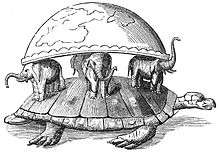World Elephant

The "world-elephants" are mythical animals, which according to some authors, appear in Hindu cosmology. However, this concept is not found anywhere in the Puranas or the Epics[1] and Al Biruni makes no mention of it, only quoting Brahmagupta who states "the earth is the only low thing".[2]
The popular rendition of the World Turtle supporting one or several World Elephants is recorded in 1599 in a letter by Emanual de Veiga.[3] Wilhelm von Humboldt suggested that the idea of a world-elephant was due to a confusion, caused by the Sanskrit noun Nāga having the dual meaning of "serpent" and "elephant" (named for its serpent-like trunk), thus representing a corrupted account of the world-serpent.[4][5][6]
The Amarakosha (5th century) lists the names of eight male elephants bearing the world (along with eight unnamed female elephants). The names listed are: Airavata, Pundarika, Vamana, Kumunda, Anjana, Pushpa-danta, Sarva-bhauma, Supratika. Four names are given in Ramayana 1.41: Viru-paksha, Maha-padma, Saumanas, Bhadra.[7]
Brewer's Dictionary of Phrase and Fable lists Maha-pudma and Chukwa are names from a "popular rendition of a Hindu myth in which the tortoise Chukwa supports the elephant Maha-pudma, which in turn supports the world".[8] The spelling Mahapudma originates as a misprint of Mahapadma in Sri Aurobindo's 1921 retelling of a story of the Mahabharata,
Love and Death.
- On the wondrous dais rose a throne,
- And he its pedestal whose lotus hood
- With ominous beauty crowns his horrible
- Sleek folds, great Mahapudma; high displayed
- He bears the throne of Death. There sat supreme
- With those compassionate and lethal eyes,
- Who many names, who many natures holds;
- Yama, the strong pure Hades sad and subtle,
- Dharma, who keeps the laws of old untouched.[9]
References
- ↑ "J L Brockington, Indology mailing list". Listserv.liv.ac.uk. 2010-04-02. Retrieved 2013-04-14.
- ↑ "INDOLOGY archives - April 2010 (#8)". Listserv.liv.ac.uk. 2010-04-02. Retrieved 2013-04-14.
- ↑ J. Charpentier, 'A Treatise on Hindu Cosmography from the Seventeenth Century (Brit. Mus. MS. Sloane 2748 A).' Bulletin of the School of Oriental Studies, University of London 3(2) (1924), pp. 317-342, citing John Hay, De rebus Japonicis, Indicis, and Peruanis epistulæ recentiores (Antwerp, 1605, p. 803f.)
- ↑ Sadashiv Ambadas Dange, Glimpses of purāṇic myth and culture (1987), p. 70.
- ↑ "INDOLOGY archives - April 2010 (#17)". Listserv.liv.ac.uk. Retrieved 2013-04-14.
- ↑ "INDOLOGY archives - April 2010 (#33)". Listserv.liv.ac.uk. Retrieved 2013-04-14.
- ↑ "Monier-Williams, ''Indian Wisdom'', p. 430f". Books.google.com. Retrieved 2013-04-14.
- ↑ Brewer's Dictionary of Phrase and Fable, 15th ed., revised by Adrian Room, HarperCollins (1995), p. 1087. also 14th ed. (1989).
- ↑ "Love and Death: Love and Death". Sacred-texts.com. Retrieved 2013-04-14.